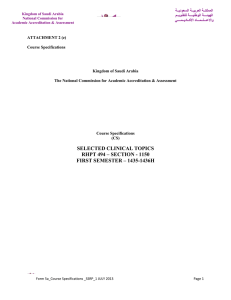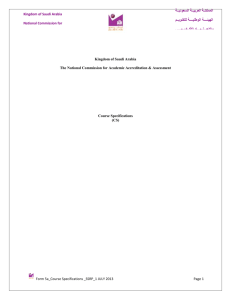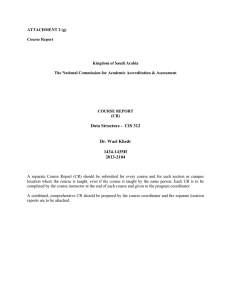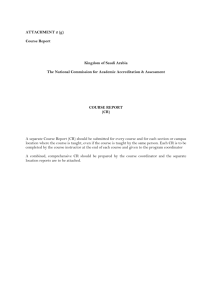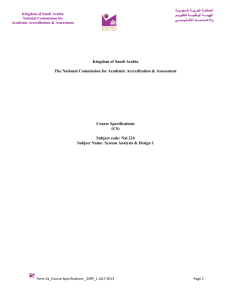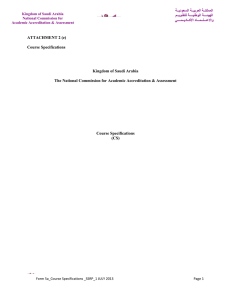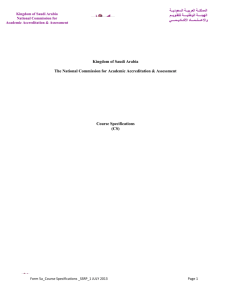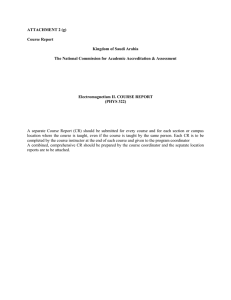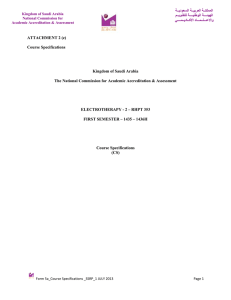PHT 328 - Course Specification
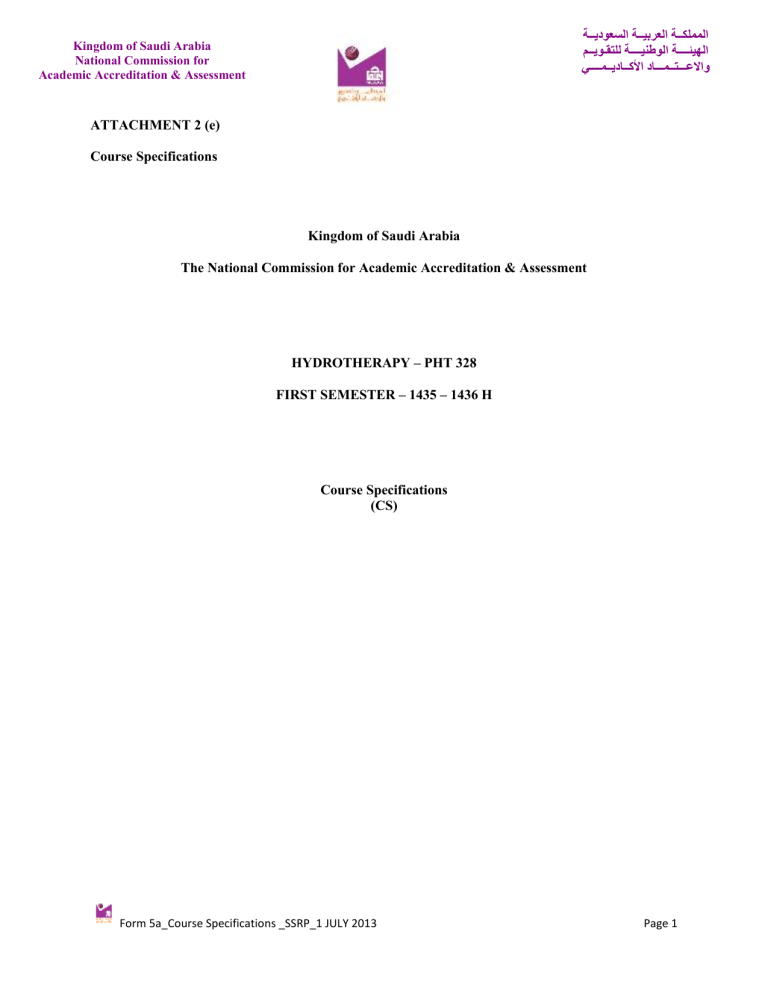
Kingdom of Saudi Arabia
National Commission for
Academic Accreditation & Assessment
ATTACHMENT 2 (e)
Course Specifications
Kingdom of Saudi Arabia
The National Commission for Academic Accreditation & Assessment
HYDROTHERAPY – PHT 328
FIRST SEMESTER – 1435 – 1436 H
Course Specifications
(CS)
ةــيدوعسلا ةــيبرعلا ةــكلمملا
م ــيوـقتلل ةــــينطولا ةــــئيهلا
يــــمــيداــكلأا داـــمــتـــعلااو
Form 5a_Course Specifications _SSRP_1 JULY 2013 Page 1
Kingdom of Saudi Arabia
National Commission for
Academic Accreditation & Assessment
ةــيدوعسلا ةــيبرعلا ةــكلمملا
م ــيوـقتلل ةــــينطولا ةــــئيهلا
يــــمــيداــكلأا داـــمــتـــعلااو
Institution
Course Specifications
Majmaah University Date of Report: (31/8/2014) -5-11-1435
1 st Semester -1435-1436
College/Department : College of Applied Medical Sciences /
Department of Physical Therapy & Health Rehabilitation
A. Course Identification and General Information
1.
Course title and code: Hydrotherapy, PHT 328
2. Credit hours: 2
3. Program(s) in which the course is offered.
(If general elective available in many programs indicate this rather than list programs)
Physical Therapy & Health Rehabilitation
4. Name of faculty member responsible for the course
Loganathan Chandrasekar (Male Section)
Dr. Intsar Salim Abd El-Aziz Waked (Female Section)
5. Level/year at which this course is offered: Level – 5 / 3 rd Year
6. Pre-requisites for this course (if any): NA
7. Co-requisites for this course (if any): NA
8. Location if not on main campus:
9. Mode of Instruction (mark all that apply)
100%
NA
NA
NA
f. Other What percentage?
NA
Comments:
NA
Form 5a_Course Specifications _SSRP_1 JULY 2013 Page 2
Kingdom of Saudi Arabia
National Commission for
Academic Accreditation & Assessment
ةــيدوعسلا ةــيبرعلا ةــكلمملا
م ــيوـقتلل ةــــينطولا ةــــئيهلا
يــــمــيداــكلأا داـــمــتـــعلااو
B Objectives
1. What is the main purpose for this course?
The main purpose of this course is to enable the student to utilize the hydrotherapy modalities to develop a plan of care, recognizing and addressing the present clinical symptom (Holistic Approach) of various patients.
2. Briefly describe any plans for developing and improving the course that are being implemented. (e.g. increased use of IT or web based reference material, changes in content as a result of new research in the field)
1.
Updating course material.
2.
Updating references used.
3.
Students will be encouraged to do the following: a.
Acquiring knowledge through the Internet, journals and verifying the other educational information resources. b.
Sharing the acquired knowledge with critical/lateral thinking & clinical reasoning.
C. Course Description (Note: General description in the form to be used for the Bulletin or handbook should be attached)
This course deals with the natural properties of water, the practical application of physical therapy, as it also addresses the physiological effects of the treatment of cooling water treatment, its uses, its dangers and preventive measures to be used, in addition to ways of using water treatment devices and how to take care of it, students are trained in the use of these devices.
1. Topics to be Covered
List of Topics No. of
Weeks
02
Contact Hours
08
Hydrocollator
Introduction, The description of Unit, The pack, Indications,
Contraindications, Advantages & Disadvantages, Dangers & precautions,
Biological effects & Technique / different methods of Application.
Practical demonstration of techniques / methods to various regions of the human body.
Cryotherapy
Introduction, The description of Unit, Physiological & Therapeutic effects,
Indications, Contraindications & Precautions, Methods of Applications of
Cryotherapy. Practical demonstration of techniques / methods to various regions of the human body.
Fluidotherapy
Introduction, The description of Unit, Physiological & Therapeutic effects,
Indications, Contraindications & Precautions, Methods of Applications.
Practical demonstration of techniques / methods to various regions of the human body.
02
01
08
04
Form 5a_Course Specifications _SSRP_1 JULY 2013 Page 3
Kingdom of Saudi Arabia
National Commission for
Academic Accreditation & Assessment
ةــيدوعسلا ةــيبرعلا ةــكلمملا
م ــيوـقتلل ةــــينطولا ةــــئيهلا
يــــمــيداــكلأا داـــمــتـــعلااو
Contrast Bath
Introduction, The description of Unit, Physiological & Therapeutic effects,
Indications, Contraindications & Precautions, Methods of Applications.
Practical demonstration of techniques / methods to various regions of the human body.
Paraffin wax Bath
Introduction, Physical characteristics of wax, Equipment, Operation of
Apparatus, Care of Apparatus, Physiological & Therapeutic effects,
Indications & contra indications, Precautions, Advantages &
Disadvantages, Methods of skills of Applications. Practical demonstration of techniques / methods to various regions of the human body.
Whirlpool Bath / Hubbard Tank
Introduction to hydrotherapy, The physics of water at rest as well as in motion & its relationship to aquatic rehabilitation, Equipment, Indications,
Contraindications, Physiological & Therapeutic effects, Demerits &
Hazards, Rehabilitative Applications – Points to discuss, Practical
Application / Technique for training balance, strengthening, Mobilization, wound debridement & analgesia & sedation.
2. Course components (total contact hours and credits per semester):
Tutorial Laboratory
Contact
Hours
Credit
Lecture
30
2
Practical
30
1
3. Additional private study/learning hours expected for students per week.
03
04
01
Other:
12
16
04
Total
60
3
2 hrs.
4. Course Learning Outcomes in NQF Domains of Learning and Alignment with Assessment Methods and Teaching Strategy
Course Learning Outcomes, Assessment Methods, and Teaching Strategy work together and are aligned.
They are joined together as one, coherent, unity that collectively articulate a consistent agreement between student learning, assessment, and teaching.
The National Qualification Framework provides five learning domains. Course learning outcomes are required. Normally a course has should not exceed eight learning outcomes which align with one or more of the five learning domains. Some courses have one or more program learning outcomes integrated into the course learning outcomes to demonstrate program learning outcome alignment. The program learning outcome matrix map identifies which program learning outcomes are incorporated into specific courses.
On the table below are the five NQF Learning Domains, numbered in the left column.
First , insert the suitable and measurable course learning outcomes required in the appropriate learning domains (see suggestions below the table). Second , insert supporting teaching strategies that fit and align with the assessment methods and intended learning outcomes. Third , insert appropriate assessment
Form 5a_Course Specifications _SSRP_1 JULY 2013 Page 4
Kingdom of Saudi Arabia
National Commission for
Academic Accreditation & Assessment
ةــيدوعسلا ةــيبرعلا ةــكلمملا
م ــيوـقتلل ةــــينطولا ةــــئيهلا
يــــمــيداــكلأا داـــمــتـــعلااو methods that accurately measure and evaluate the learning outcome. Each course learning outcomes, assessment method, and teaching strategy ought to reasonably fit and flow together as an integrated learning and teaching process. Fourth , if any program learning outcomes are included in the course learning outcomes, place the @ symbol next to it.
Every course is not required to include learning outcomes from each domain.
NQF Learning Domains
And Course Learning Outcomes
1.0 Knowledge
1.1 Define the principles of physical laws governing
@ different hydrotherapy application.
Course Teaching
Strategies
Course Assessment
Methods
Theory Exam
1.2
@
Describe the equipment, operation of apparatus, physiological & therapeutic effects, indication, contraindication, advantages, dis-advantages, precaution
& dangers of various hydrotherapy modalities.
Lecture, Lecture demonstration & class discussion by teacher,
Text book assignments, open text book study, homework
& practice, summarizing & note taking, daily re-looping of previously learned material
2.0 Cognitive Skills
2.1 Justify each equipment used/selected for the treatment in
@ the field of hydrotherapy.
Case method, use of motion pictures, educational films, pod cats & video tapes
Theory Exam +
Practical Exam
2.2
@
Able to evaluate & reconstruct the rehabilitation if necessary for each individual patient according to the follow up.
3.0 Interpersonal Skills & Responsibility
3.1
4.0 Communication, Information Technology, Numerical
4.1
5.0 Psychomotor
5.1
@
5.2
@
Demonstrate s
afely the application of different hydrotherapy modalities in certain diseases or disorders.
Illustrate
the each basic procedures systematically.
Teacher demonstration, Lab manual, Nonlinguistic representation (Physical models, Kinesthetic representations), Simulation/
Role playing, Hands on, active participation
Practical demonstration / case presentation with the model, Logbook
Knowledge
Suggested Guidelines for Learning Outcome Verb, Assessment, and Teaching
NQF Learning Domains Suggested Verbs list, name, record, define, label, outline, state, describe, recall, memorize, reproduce, recognize, record, tell, write
Cognitive Skills estimate, explain, summarize, write, compare, contrast, diagram, subdivide, differentiate, criticize, calculate, analyze, compose, develop, create, prepare, reconstruct, reorganize, summarize, explain, predict, justify, rate, evaluate, plan, design, measure, judge, justify, interpret, appraise
Form 5a_Course Specifications _SSRP_1 JULY 2013 Page 5
Kingdom of Saudi Arabia
National Commission for
Academic Accreditation & Assessment
ةــيدوعسلا ةــيبرعلا ةــكلمملا
م ــيوـقتلل ةــــينطولا ةــــئيهلا
يــــمــيداــكلأا داـــمــتـــعلااو
Interpersonal Skills & Responsibility demonstrate, judge, choose, illustrate, modify, show, use, appraise, evaluate, justify, analyze, question, and write
Communication, Information
Technology, Numerical
Psychomotor demonstrate, calculate, illustrate, interpret, research, question, operate, appraise, evaluate, assess, and criticize demonstrate, show, illustrate, perform, dramatize, employ, manipulate, operate, prepare, produce, draw, diagram, examine, construct, assemble, experiment, and reconstruct
Suggested verbs not to use when writing measurable and assessable learning outcomes are as follows:
Consider Maximize Continue Review Ensure Enlarge Understand
Maintain Reflect Examine Strengthen Explore Encourage Deepen
Some of these verbs can be used if tied to specific actions or quantification.
Suggested assessment methods and teaching strategies are:
According to research and best practices, multiple and continuous assessment methods are required to verify student learning. Current trends incorporate a wide range of rubric assessment tools; including web-based student performance systems that apply rubrics, benchmarks, KPIs, and analysis. Rubrics are especially helpful for qualitative evaluation.
Differentiated assessment strategies include: exams, portfolios, long and short essays, log books, analytical reports, individual and group presentations, posters, journals, case studies, lab manuals, video analysis, group reports, lab reports, debates, speeches, learning logs, peer evaluations, self-evaluations, videos, graphs, dramatic performances, tables, demonstrations, graphic organizers, discussion forums, interviews, learning contracts, antidotal notes, artwork,
KWL charts, and concept mapping.
Differentiated teaching strategies should be selected to align with the curriculum taught, the needs of students, and the intended learning outcomes. Teaching methods include: lecture, debate, small group work, whole group and small group discussion, research activities, lab demonstrations, projects, debates, role playing, case studies, guest speakers, memorization, humor, individual presentation, brainstorming, and a wide variety of hands-on student learning activities.
1
2
5. Schedule of Assessment Tasks for Students During the Semester
Assessment task (e.g. essay, test, group project, examination, speech, oral presentation, etc.)
First Midterm exam Theory
First Midterm exam Practical
3
4
5
Second Midterm exam – Theory
Quiz (3x5=15)
Assignments & Log book
6 Final Practical Exam
7 Final exam – Theory
Week Due
6
6
12
During the course
Throughout the course
15
16
Proportion of Total
Assessment
10%
15%
10%
15%
10%
10%
30%
Form 5a_Course Specifications _SSRP_1 JULY 2013 Page 6
Kingdom of Saudi Arabia
National Commission for
Academic Accreditation & Assessment
ةــيدوعسلا ةــيبرعلا ةــكلمملا
م ــيوـقتلل ةــــينطولا ةــــئيهلا
يــــمــيداــكلأا داـــمــتـــعلااو
D. Student Academic Counseling and Support
1. Arrangements for availability of faculty and teaching staff for individual student consultations and academic advice. (include amount of time teaching staff are expected to be available each week)
Dr. Intsar
Sunday
Monday
Day Mr. Loganathan Chandrasekar
10 am – 11.50 am & 1- 1.50 pm
Tuesday
Wednesday
Thursday
2- 2.50 pm
10 am – 11.50 am & 1- 2.50 pm
10 am – 11.50 am
E. Learning Resources
1. List Required Textbooks a. Physical agents in rehabilitation: From research to practice. Michel Cameron. 3 rd edition, Saunders
2. List Essential References Materials (Journals, Reports, etc.) ptjournal .apta.org www.ptnow.org/ Journals /Default.aspx
3. List Recommended Textbooks and Reference Material (Journals, Reports, etc)
a. Hydrotherapy: Principles & Practice, 2 nd Edition, Author Margaret Reid. Butterworth b. Laboratory Manual for Physical Agents: Theory & Practice, 2 nd Edition, Barbara J. Behrens. c.
Therapeutic Modalities in Rehabilitation, 3rd Edition, Author –William E. Prentice.
McGraw-
Hill
4. List Electronic Materials (e.g. Web Sites, Social Media, Blackboard, etc.) a. http://www.wcpt.org/apti b.
http://www.halliwick.net/en/
5. Other learning material such as computer-based programs/CD, professional standards or regulations and software.
F. Facilities Required
Indicate requirements for the course including size of classrooms and laboratories (i.e. number of seats in classrooms and laboratories, extent of computer access etc.)
1. Accommodation (Classrooms, laboratories, demonstration rooms/labs, etc.)
Lecture room suitable for 25 students.
Separate Practical lab suitable for 10 - 15 students.
2. Computing resources (AV, data show, Smart Board, software, etc.)
One computer in the classroom, and another in the lab.
3. Other resources (specify, e.g. if specific laboratory equipment is required, list requirements or attach list)
The list of detailed lab accessories and other required equipment’s are attached.
G Course Evaluation and Improvement Processes
Form 5a_Course Specifications _SSRP_1 JULY 2013 Page 7
Kingdom of Saudi Arabia
National Commission for
Academic Accreditation & Assessment
ةــيدوعسلا ةــيبرعلا ةــكلمملا
م ــيوـقتلل ةــــينطولا ةــــئيهلا
يــــمــيداــكلأا داـــمــتـــعلااو
1 Strategies for Obtaining Student Feedback on Effectiveness of Teaching a.
Written questionnaire at the end of the semester. b.
Web based questionnaire at the end of semester.
2 Other Strategies for Evaluation of Teaching by the Program/Department Instructor a.
Peer review b.
Internal exam report analysis c.
Course report analysis d.
Mapping of Course Outcome.
3 Processes for Improvement of Teaching a.
Efficient & effective use of teaching methods. b.
Implementation and regulation of unified course outcomes and class objectives in both male & female sections. c.
Unified assessment methods based on rubrics.
d.
Involvement of faculty members in various professional activities by attending frequent workshops/CME etc. for continuous up gradation of knowledge & skills.
4. Processes for Verifying Standards of Student Achievement (e.g. check marking by an independent member teaching staff of a sample of student work, periodic exchange and remarking of tests or a sample of assignments with staff at another institution)
NA
5 Describe the planning arrangements for periodically reviewing course effectiveness and planning for improvement. a.
S
tudents feedback analysis
b.
Course report analysis c.
Peer review report
Based on these reports the department make the strategic action plan for each semester.
Faculty or Teaching Staff: 1. Dr .: Intsar Salim Abd El-Aziz Waked (Female section) &
2. Mr. Loganathan Chandrasekar (Male section)
Signature: 1._______________________________
Signature: 2._______________________________ Date Report Completed: 31 August 2014
Received by: _____________________________ Dean/Department Head: Dr. Fuzail Ahmad
Signature: _______________________________ Date: _______________
Form 5a_Course Specifications _SSRP_1 JULY 2013 Page 8
